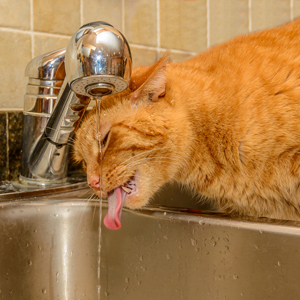Cats who eat a dry diet need more water than those on canned food.
Original Article from:
As a general rule, cats and water don’t get along, but did you know that many cats will avoid getting water in them as well as on them? Sometimes, getting water into a cat is as challenging as getting a cat into water.
It seems reasonable to expect that when cats get thirsty they will drink, but cats don’t have that long-standing reputation for being finicky for no reason! Sometimes it seems that along with their inherent aversion to water, cats also seem to have an aversion to doing whatever it is you want them to do, even when it’s in their best interest. You can lead a cat to water but you can’t make him drink.
A 7-pound cat’s minimim water requirement is 5 ounces per day. That assumes that the cat is hanging out in a nice temperate environment, not outside in tremendous heat or being chased up a tree and spending energy and fluids with exercise. This minimum also assumes that it’s a normal, healthy cat, not an old one with kidneys that aren’t up to speed any more. Of course the requirement goes up as the cat gets bigger or more active. For a normal, healthy, small to medium-sized cat, 5 to 10 ounces of water per day is probably fine.
Cats who eat a primarily dry diet need to drink more than cats who eat mostly wet food, as wet food already contains about 70-80 percent water. If kitty’s diet consists of mostly canned food, she’s likely getting a good portion of her daily water requirement just from eating. For the rest, fresh, clean water should be available at all times.
Since we can’t observe our feline friends’ behavior all day every day, we can’t really be sure how much water is actually ending up inside them. When you consider the potential health issues that can occur if your cat doesn’t drink enough, making some small changes around the house and to your daily routine in order to avoid those issues is more than worth the trouble.
Among the most common health issues that can arise from dehydration are constipation, urinary tract and/or bladder inflammation, and urinary blockage. Blockages occur when enough crystals/stones form to prevent urination. A serious blockage of the urethra, the thin tube that transfers cat pee from the bladder to your favorite rug and your new shoes, can very quickly become life-threatening. Blockages are most common in male cats, as the urethra is narrow and more easily obstructed. If you see blood in kitty’s urine or feces or he seems to be straining to pee or poop, the best thing to do is get him to your veterinarian immediately.
If you have a senior cat, helping her stay adequately hydrated is even more important, as her aging kidneys need all the help they can get to keep functioning properly.
Some cats are especially finicky and need a little extra enticement to bring them to the water bowl. If your cat isn’t into canned food (surprisingly, some prefer dry!) there are several ways you can help encourage your cat to drink more water.
- Try switching to a mostly canned diet. Cats are creatures of habit, so change can be hard for them to accept. Consult with your veterinarian before you change the diet as they can help you select the best food for your cat and give you tips to make the transition smooth and successful.
- Wash and refill your cat’s water bowl daily. You wouldn’t want to drink from a glass of water that’s been sitting around on the floor for three days, so your cat probably doesn’t either. He is way more finicky than you about things like that, most likely.
- Put several water bowls throughout your home in different locations. With their well-earned reputation for being finicky, it’s no surprise that some cats will show a preference for drinking from certain spots in the home over others.
- Try different kinds of water bowls. Just like with the location of the water bowl, kitty may have a preference for a certain type of bowl. Try rotating between metal, plastic, and ceramic bowls. Cats often prefer wide, shallow bowls because they don’t like sticking their faces down inside a bowl with tall sides.
- Never keep kitty’s food and water next to or near the litter box. Cats may be animals but chances are high that even they don’t like to eat or drink next to the odor (and possible contamination from) their toilet.
- Add appetizing flavor to the water. A few drops of tuna juice (from tuna packed in water – not oil!) or chicken broth can make kitty more inclined to drink. Make sure you limit the amount of sodium in whatever you add to your cat’s water.
- Feed smaller meals, more frequently. Eating triggers thirst so eating more often could lead to drinking more. Be careful not to overfeed, though.
- Try a water fountain. Many cats are attracted by the moving water and the circulation helps to keep the water fresh. Some cats need time to get used to it though, so if you’re trying it for the first time and kitty doesn’t seem interested, leave it running for a couple of weeks before you give up on it.
You probably don’t need to try all of these ideas to get your cat to drink more water, but implementing just a couple of them could make a huge difference and help keep your cat hydrated, healthy, and happy longer.






Sorry, comments are closed for this post.